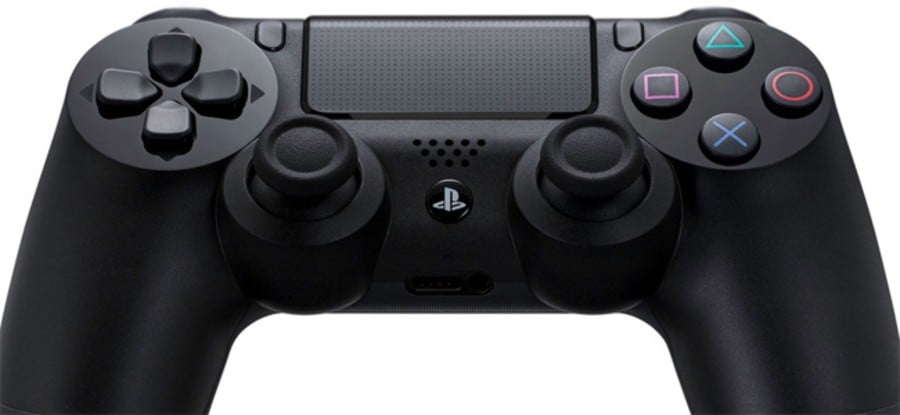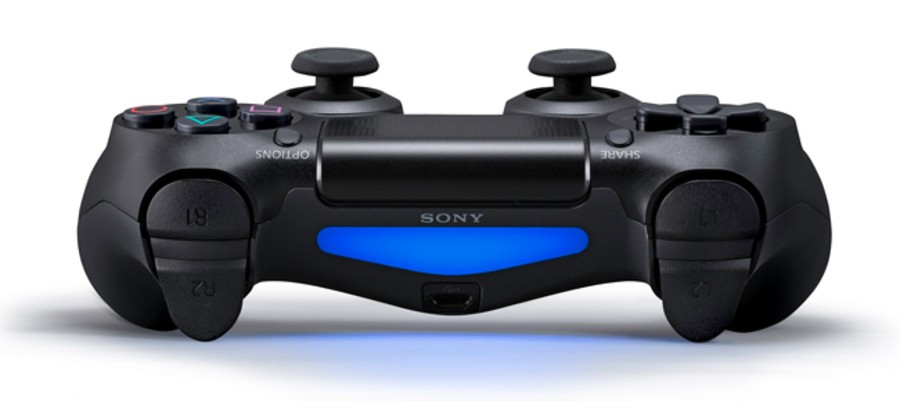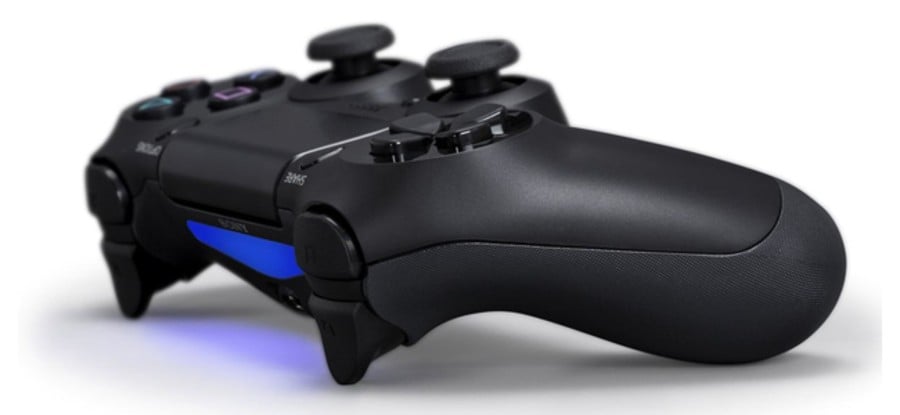
A console without a controller is like a car without a steering wheel: useless. While a vehicle’s helm provides the pivotal interaction between the wheels and the road, video game systems have forever been defined by the device’s that drive them. Sony evidenced this earlier in the year when it opted to unveil its overhauled DualShock 4 peripheral ahead of the PlayStation 4 console itself. This decision was borne out of the platform holder’s desire to divulge the improvements that it had made to its flagship peripheral. But is the next generation input option the revolution that we were promised, or merely an iteration in a slightly different shell?
While it may wear the same name as its predecessors, the PS4 controller represents the biggest change to the DualShock family since its very inception. Granted, the Japanese giant has introduced various new features over the years – the PlayStation 3 version augmented wireless capabilities and SIXAXIS motion controls – but the shape has remained the same since the greyscale days of the PSone. That’s no longer the case, however. Wrap your fingers around the DualShock 4 and you’ll find a much larger utensil with handles that protrude much further than its forefather. This gives the device a much greater sense of grip, and eradicates the cramped layout of previous peripherals.
 Watch on YouTube
Watch on YouTubeSubscribe to Push Square on YouTube166k
The matte plastic on the front of the unit has the same soft touch as the DualShock 3, but it’s the back of the device that provides a pleasant texture change. A crosshatched plastic gives the controller a slightly rougher surface, which feels especially pleasant in the palms of your hand and across the mid-surface of your pinkie and ring finger. Of course, the extended length of the handles means that an average sized paw has plenty of room to work with here, where there wasn’t a whole lot to grab onto on the PS3’s controller.

It’s cleverly moulded, too. While the DualShock 4 maintains the iconic shape of its predecessor, there are more curves around the back that allow it to slot more easily into your grasp. The contours of the unit also encourage your index and, if you’re such a way inclined, middle fingers to rest on the shoulder buttons at the top of the unit. It’s this area that’s arguably seen the most changes, with the L1 and R1 buttons given a slightly more pronounced curve that matches the final bend of your pointer. Meanwhile, the L2 and R2 triggers now have a pleasing lip that prevents your fingers from slipping off – a key improvement compared to the stubby solution found on the DualShock 3.
It’s an enormous step forward, but we still feel that the triggers are stationed a little too far back if you intend to use them with your index fingers. Personally, we’ve always double-teamed the various iterations of the DualShock controller – with our pointers over the L1 and R1 buttons, and our middle digits above the L2 and R2 triggers – and this still feels like the way that the controller was designed. It’s an enormous step forward from the PS3’s option, though, and you no longer feel like you’re going to drop the device when you spend a prolonged period pulling down either of the triggers when firing a weapon or accelerating a car.
The addition of resistance to the triggers makes them significantly more satisfying to heave, too, but is contrasted by slightly more firm face buttons. With the spongy pressure detection of the DualShock 3 whipped out, the famous Triangle, Circle, Cross, and Square buttons have a touch more springiness to them, which is perhaps a little too strong on the new Share and Options inputs. These replace the classic rubberised Start and Select buttons, and augment the controller with some new options. Meanwhile, the disconnected d-pad lacks the responsiveness of the PlayStation Vita’s tactile alternative, but isn’t quite as stiff as its current generation sibling, and thus doesn’t force the controller to groan as you roll out attack patterns in Injustice: Gods Among Us.

The final major cosmetic tweak pertains to the analogue sticks, which now boast an indent that’s designed to cup your thumb tips. The wider shape of the controller means that your digits are no longer likely to clash in the centre, while the deadzone has been decreased to provide a more accurate response in games. The slippery triggers of the DualShock 3 were supposedly requested by Gran Turismo creator Polyphony Digital at the start of the previous generation, but first-person shooters played a much bigger role in the new device. As such, the joysticks feel much sturdier, a tweak demanded by Killzone: Shadow Fall developer Guerrilla Games that’s allowed the Dutch outfit to eliminate auto-aim from its next generation launch title entirely. Adjusting to the stiffness of the sticks can be a challenge at first, but the added precision makes this an alteration worth overcoming.
Of course, the tweaks aren’t solely cosmetic. In addition to the laundry list of refinements, the DualShock 4 is actually a fairly technologically dense piece of kit. Positioned to the top of the unit – between the two main triggers – is a light bar able to cycle through various different hues. While this is primarily used to distinguish between different players, it can also be employed by developers to offer additional in-game feedback. For example, Sony’s abovementioned system showpiece employs the tool to demonstrate when you’re low on health by gradually switching from green to red. In truth, it’s not overly helpful, as unless you’re playing in the dark, the addition of the ambient light is difficult to determine. In fact, depending on your seating position, the illuminating strip’s biggest benefit appears to be adding glare to your television screen – an issue exacerbated by the fact that it can’t be switched off.
The platform holder stresses that the light bar will also be useful in motion control titles, operating with the new PlayStation Camera to detect your position, but outside of augmented reality application The Playroom, its usefulness is still somewhat in doubt. The free on-board hardware demonstration is a good showpiece for the technology, allowing you to summon a flexible Pong board onto the screen and squirt virtual champagne around your relieved living room, but it’s hard to imagine this functionality getting much use at all. The same applies to the touchpad, which aside from acting as a gigantic additional button, feels a little surplus to requirements. It’s nicely textured and extremely responsive to the touch, but outside of cycling secondary abilities in Killzone: Shadow Fall has yet to really demonstrate its purpose.

Fortunately, the improvements to the rumble sensors and accelerometers are much more worthwhile. The inclusion of multiple motors means that weapons and vehicles have a lot more kick, and developers are able to program much more nuanced vibrations across the entire width of the controller. Meanwhile, the motion sensors boast the same enhanced accuracy of the Vita and PlayStation Move wands, which means that titles such as flower really flourish thanks to the silky smooth tracking. It’s still unclear whether developers will actually take advantage of this feature, but it’s nice knowing that it’s no longer hampered at a hardware level should a studio want to try. If nothing else, typing out messages with motion controls using the system keyboard is a refreshing treat.
The last major addition is the Nintendo Wii-esque speaker, which has an inevitable tinny quality to it. It’s surprisingly loud, but works fine, and when sparingly used helps to add some dimension to your soundscapes. We’re not convinced that playing audio messages through the output such as in Killzone: Shadow Fall is the right solution, but the additional guidance offered in Resogun makes sense. It’s a shame that the combination of all of these power hungry features means that a single DualShock 4 charge won’t last you quite as long as the DualShock 3, but the playtime is still perfectly adequate, and the ability to charge the device with the console actually turned off helps to alleviate any frustrations here.
Minor quibbles aside, then, the PS4 controller represents a sizeable step forward for Sony’s oft-criticised input solution. While sceptics will still lament the symmetrical layout of the device, such complaints boil down to personal preferences, rather than larger design flaws of the new device. Remarkably, the platform holder has managed to overhaul almost every aspect of its previous peripherals, without actually squandering the iconic form factor and functionality that has made the DualShock a mainstay in most gamers’ homes for the past 15 or so years. Some of the gimmicks such as the touchpad and light bar are yet to really prove their worth, but even if they are ignored for the rest of the peripheral’s lifespan, the improved form factor, redesigned triggers, and sturdier sticks will still ensure that the unit is a success over the years. The DualShock 4 is not an input revolution on the scale that Nintendo likes to introduce – but it undeniably ensures that interacting with Sony’s next generation system is more enjoyable than any of the PlayStation platforms that have come before. And if that simple appraisal pushes your buttons, then you’ll get along with the new controller just fine.
What are your thoughts on the DualShock 4 controller? Is it the step forward that you hoped for, or do you feel that it’s a bit of a regression compared to the PS3’s packaged peripheral? Do you think that the new gimmicks such as the light bar are worthwhile additions, or a waste of time? Tickle our touchpad in the comments section below.





Comments 13
I used both gen controllers at Eurogamer and the DS4 just felt more natural. It feels moulded to the players hand where as the XB1 controllers forces the player to change their way of holding.
I thought the speaker sounded pretty decent on KZ, much better than the wiimote's speaker. Idk if it's a huge issue that can be ironed out through firmware, but it seems that my controller occasionally can't sync with my PS4. I've tried turning it on with the PS button but it doesn't activate the PS4 until I turn the ps4 on manually, turn it off and then turn it on via DS4. It's happened twice so far.
I've always loved the feel of the DualShock, but the DualShock 4 is a massive improvement over its older brothers. It feels like it was made for your hands and your hands only, which is more than I can say for the Xbone controller.
I asked my co-workers if the lightbar reflected off their screen and they said "no". The Move never left any kind of noticeable glare on my screen, so I don't see why anyone would have a problem - unless they sit 2 inches away from the screen.
@irken004 I haven't had anything like that yet, fortunately. That sounds like a system software issue, to be honest - I'm sure a future "stability" update will fix that over time.
@BornOfEvil I sit quite close to my screen and you can see it if you hold it up. Fortunately, I have the controller in my lap which is just below my screen so there's no real issue. I think an option to turn it off would be good, though. I think it's a neat feature, but can understand why some people may not want it on.
We get the PS4 in 3 days so i cannot comment on the DS4 just yet, but what i've seen looks very good. About the touchpad & the motion sensors i definitely think developers will use them, not all of them but i think you'll see these get used else whats the point in them. The likes of Media Molecule will 100% use them Blissard is also using the touchpad, i also think Sony's first party dev's will use them also. Well thay are Sucker Punch for Infamous Second Son, well only 3 days to wait now for the PS4.
So is any 3.5 mm headphone able to plug into this controller to remove the game sound from the tv to the headphones?
The DS4 is only compatible to work with certain games on the PS3 is that correct or is it all the PS3 games? Just curious I would like to play my ps3 games using the superior Ps4 controller.
@NorthLightSuplx so far I have used my iphone earbuds.. For some reason the mic didnt work but sound did, my beats by dre headphones worked fully sound and chat.. And I used my skull candys once to play AC because of their comfort all worked!
Easily the best, and most comfortable, controller of this console generation. I like the Xbox One's as well but the changes Sony made when it comes to the DS4 have made all the difference. Took an already very good design and has damn-near perfected it. I like the trigger-like feel of the L2, R2 buttons, love that they added a touchpad (I can see this saving on wear and tear on the buttons like I've already noticed with Injustice allowing you to use the touchpad for mini games rather than mash the face buttons, and it gives developers more options to work with for commands). The speaker even is high quality and added to the experience in Killzone, it's gimmicky but I could see the more creative developers out there using it in cool ways. The lightbar I'm kind of indifferent to but it was pretty cool how it'd change colors in Killzone to let you know how much health you have. The thing is though, who's really going to look at the light bar when they're focused on the game? Still, awesome controller overall, seems like Sony took all the advice it got from developers very seriously and delivered.
The triggers are in a more pistol-like position than DS3s if you use your index, which is comfy for me. Gets kinda tiring using semi-auto guns in BF4 cause of the pull resistance, but it's more realistic so it's a plus. I can't wait to use them as brake / gas in GT7. Everything's better : )
@NorthLightSuplx Yes any 3.5mm headset can be used to stream the audio away from your TV. Its a great feature when you need to be quiet but want to be able t hear your games.
Awesome to know thanks for the replies!
This has been my new favorite controller since 2/21/2013!!!
This is what I am most exited about the PS4. This and the new OS.
Show Comments
Leave A Comment
Hold on there, you need to login to post a comment...